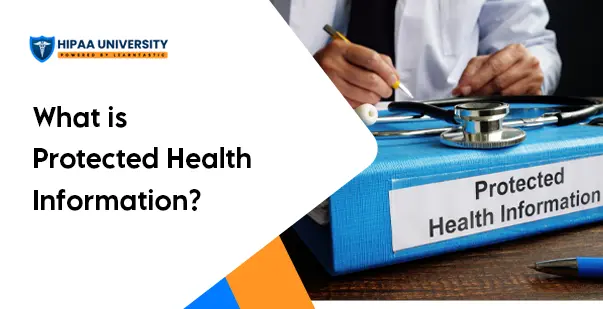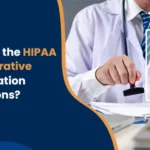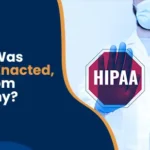What is Protected Health Information?

August 8, 2024
In today’s healthcare landscape, where digital records and electronic communication are the norm, protecting patient privacy is more critical than ever. Protected Health Information—commonly referred to as PHI—is at the core of HIPAA training and compliance efforts. Whether you work in a small clinic or a large hospital system, understanding PHI is essential for staying compliant and protecting sensitive patient data.
The main purpose of HIPAA compliance training is to ensure the confidentiality, integrity, and availability of PHI. But what exactly is protected health information? Why must it only be disclosed when absolutely necessary—and always under strict privacy safeguards?
This blog answers all your questions about PHI, so keep reading to learn how HIPAA online training can help you stay compliant and secure.
Understanding Protected Health Information (PHI)
Protected Health Information (PHI) is defined under the Health Insurance Portability and Accountability Act (HIPAA) as any health-related data that is created, received, stored, or transmitted by a covered entity or business associate—and can be used to identify a specific individual. This includes information related to a patient’s:
- Past health conditions
- Present diagnoses or treatments
- Future healthcare plans
PHI can take many forms: written, verbal, or electronic. It also includes demographic identifiers such as:
- Names
- Addresses
- Phone numbers
- Email addresses
- Medical record numbers
- Biometric identifiers like fingerprints, facial images, and voiceprints
- Genetic information
- Insurance policy numbers
Covered entities under HIPAA include healthcare providers, insurance companies, and healthcare clearinghouses. Business associates, such as billing companies or IT vendors who manage PHI on behalf of covered entities, are also required to follow HIPAA rules.
To protect this data, HIPAA training certification is required across organizations, ensuring that staff members understand what counts as PHI and how to handle it securely.
Exceptions to the PHI Definition
While HIPAA provides a broad definition of PHI, not all health-related information qualifies. Certain exceptions exist based on the context in which the data is collected and by whom. Here are key exceptions to PHI under HIPAA:
- Education Records
Student health records maintained by educational institutions are not regarded as PHI, even if they contain details like allergies or disabilities.
- Employment Records
Employment-related health information, such as sick leave documents or Occupational Safety and Health Administration (OSHA) forms, are not considered PHI because they are collected for employment purposes, not healthcare delivery.
- Device-Generated Data
Data collected by health-related devices (like fitness trackers, smartwatches, or health apps) is not PHI unless the data is shared with a covered entity for healthcare purposes. For example, heart rate data stored by the device manufacturer alone isn’t PHI—until it is used for treatment or billing.
Understanding these distinctions is key to proper HIPAA compliance training. The wrong assumptions could lead to violations—even with good intentions.
Read more: What is Considered Protected Health Information Under HIPAA?
What Is ePHI?
ePHI, or Electronic Protected Health Information, is any PHI that is created, stored, transmitted, or received in electronic form. Because of the sensitive nature of ePHI, the HIPAA Security Rule was established to set standards for protecting electronic data.
Staying compliant with the Security Rule is an important part of HIPAA certification online, and failing to protect ePHI can lead to significant penalties.
What Happens When PHI is Leaked?
A PHI breach can damage patient trust, harm an organization’s reputation, and result in substantial legal consequences. There are several common ways PHI is leaked:
- Physical Loss or Theft
Devices like laptops, smartphones, and tablets used by healthcare staff can be lost or stolen. If they store unencrypted PHI, this becomes a serious security threat.
- Cybersecurity Attacks
Hackers frequently target healthcare systems because of the high value of PHI. Weak passwords, outdated software, or unpatched systems can open the door to massive data breaches.
- Accidental Disclosures
Internal mistakes also cause violations. Examples include:
- Sending PHI to the wrong patient
- Mishandling printed records
- Employees accessing patient data without permission
- Discussing patient info in public or unsecured locations
HIPAA violations related to PHI leaks can lead to:
- Fines ranging from thousands to millions of dollars
- Legal action or lawsuits
- Loss of patient trust
- Criminal charges for willful neglect
How to Secure PHI Under HIPAA
HIPAA requires healthcare organizations to implement clear, effective practices to secure both physical and electronic PHI. These include technical safeguards, employee training, and administrative controls.
1. Train Employees
Staff must be trained on HIPAA rules when:
- They are first hired
- There are major policy changes or legal updates
According to the HIPAA Security Rule (45 CFR 164.308), organizations must “implement a security awareness and training program for all members of its workforce.” Even though HIPAA doesn’t specify how often training should be repeated, regular refreshers are best practice.
2. Implement Access Controls
Only authorized personnel should have access to PHI. This means:
- Setting up secure login credentials
- Using role-based access systems
- Restricting access based on patient assignment
A nurse working in pediatrics, for example, shouldn’t have access to adult patient records unless required.
3. Manage Third-party Vendors
If vendors handle PHI (e.g., billing companies, IT providers), they must sign a Business Associate Agreement (BAA). However, the BAA alone isn’t enough. Organizations must also:
- Review vendors’ cybersecurity policies
- Monitor access and activity logs
- Ensure vendors follow HIPAA-compliant practices
4. Backup Your Data
Backing up PHI ensures you can restore systems after a cyberattack or system failure. Backups should be encrypted and stored securely.
5. Protect Printed Records
Printed documents often get overlooked, but they can be just as vulnerable as digital data. Best practices include:
- Using locked file cabinets
- Installing keycard systems and security cameras
- Requiring password-protected printing
- Teaching staff to collect prints immediately
- Keeping printed PHI covered and secured at all times
Even leaving a printed form unattended for a few minutes could result in a breach.
6. Protect Verbal PHI
Spoken discussions of PHI must be treated with the same care as written or electronic information. HIPAA violations can occur if:
- Staff speak about patients in hallways or waiting areas
- Calls are made without privacy
- Unnecessary details are shared during consultations
To avoid these breaches:
- Use private rooms for phone calls
- Keep conversations quiet and limited to essential information
- Avoid discussing patient info where others may overhear
7. Encrypt PHI
Encryption converts PHI into unreadable code unless the correct decryption key is used. HIPAA recommends encrypting data both “in transit” (while being transmitted) and “at rest” (while stored).
Even if a hacker steals encrypted data, they won’t be able to use it. Encryption can mean the difference between a secure breach report and a costly violation.
8. Conduct Risk Assessments
HIPAA requires periodic risk assessments to identify where PHI may be exposed. These assessments help organizations:
- Pinpoint vulnerabilities
- Update policies and technology
- Educate staff on new threats
- Create better response plans
Read more: What is HIPAA Violation and Types of HIPAA Violation Categories
Examples of Protected Health Information (PHI)
PHI includes a wide range of data points that, when connected to a patient, are protected under HIPAA. Some examples include:
- Email Address: When linked to appointment reminders or medical updates.
- Fax Number: If used to send or receive lab results or prescriptions.
- Vehicle Numbers: Especially for medical transport, such as ambulances.
- Certificates or License Numbers: Related to healthcare providers in patient files.
- Full-Face Imagery: Common in diagnostic imaging or patient ID processes.
- MRI Scans: Detailed internal health images linked to patient records.
- Social Security Numbers: When tied to insurance or medical history.
- Account Numbers: Used for billing or payment of healthcare services.
- Telephone Numbers: For follow-ups, consultations, or appointment scheduling.
- Medical Record Numbers: Key identifiers in all patient files.
- Phone Records: Related to discussions about symptoms or treatments.
- Blood Test Results: Containing personal health insights and diagnoses.
Each of these examples becomes PHI when connected to a specific individual and used in the context of healthcare.
Final Thoughts
Knowing what qualifies as PHI—and how to safeguard it—is vital for any organization handling patient data. Covered entities and business associates must maintain strict safeguards to ensure confidentiality, protect against unauthorized access, and uphold HIPAA standards.
HIPAA training not only ensures compliance but also empowers staff to handle patient information with confidence and care. With proper education and proactive security strategies, breaches can be prevented, trust can be maintained, and patient rights can be preserved.





